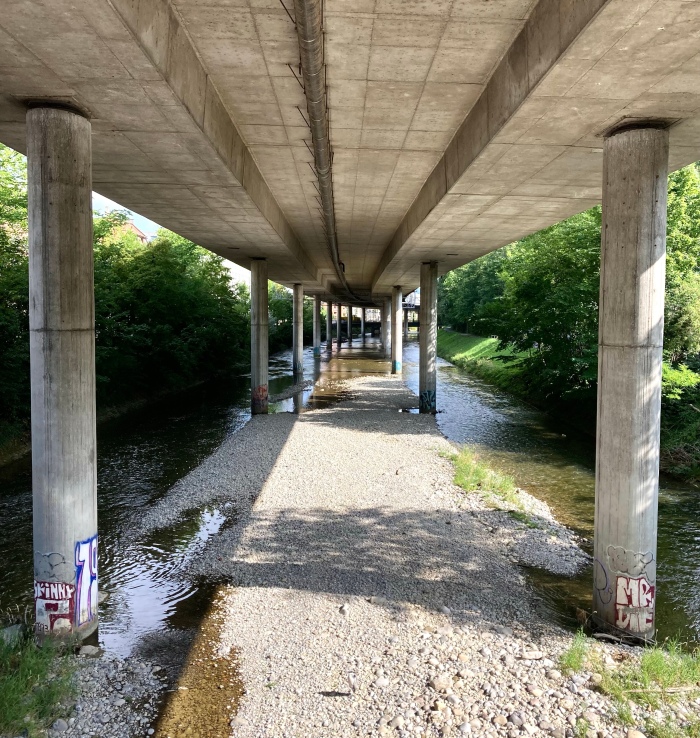
How long does it take to know a place?
Really know it: understand its routes and rhythms, its ways, inhabitants; its delights, its customs, faults and failings. I’m not sure you ever can. The two places I know the best – Bristol where I was born and grew up and London, where I’ve lived since the mid 1990s, are still, in parts, mysteries to me.
This isn’t simply due to size. Even the smallest patches will hold and keep hold of surprises and secrets. There’s a little town in the south west of France, called Confolens, I used to visit every summer for over fifteen years. Two rivers meet there – La Vienne and Le Goire. There’s an ancient bridge and a modern one. A few cobbled medieval streets meander around the old town. Larger roads stretch uphill and further out, lined with newer developments. At some point on summer evenings, House martins swap shifts with bats to flit above the river and in and out of the jumbled eaves over tight rows of leaning, older houses.
The town has a pretty, yellow pennant-hung market square. An antiques shop, that also sells plastic figurines to the delight of small children. Two bakeries. Welcoming cafes and grudging surly ones. A once beguilingly dishevelled old mill, accessed via stepping stones – now cleaned up. A former railway line that’s retired and become a footpath – running north through woods towards the next settlement along, which boasts an impressive ruined castle on a hill. Beneath this, there’s a shop selling bric-a-brac and second-hand books – most of them in English. After many visits, I know my way around, but I couldn’t say I know it in any deeper sense than that.
All of which is an acknowledgment that even if you frequent somewhere often, or live there, while you can come to understand aspects of it intimately, you’ll never know everything. Places, like people, exist in flux. Even when a place appears to stay the same, it will keep on changing and no one visitor can ever keep up. Not entirely. That said, I love few things more than going somewhere and picking up impressions. There’s a great satisfaction, excitement at times in discovering a sense, however superficial, of a place, large or small, urban or rural.
However, on a brief visit, as tourist or a traveller, all you can ever hope to do is gather glimpses. Construct a flickering sense of the lay of the land and how that relates to you, your memories and experience.
When I’ve been someplace new, I’ve often found first impressions can be thrilling. A child kicking a ball against an ancient stone pillar, at the edge of a Roman piazza for example; while the loud chatter of people and starlings fills the air, competing with the buzz of Vespas and tooting car horns. A brimming sense of life and long history and possibility can quickly bubble into excitement.
On other occasions I’ve found it hard to get any sense of somewhere at all. Recently, I went to Zurich and I struggled. My place antennae twitched, but could not pick up a signal.
Obviously, life happens there – but aside from getting over excited at the site of red kites gliding over the Opera House by the lake; when wandering about in the town centre, the shops, the lake shore, side streets, main roads, parks, galleries and churches, everything seemed somehow muted, strangely distant.
Near the hotel, the waters of the Schanzengraben (a kind of moat in the old city) put UK waterways to shame. Rather than shit and litter, fish could be seen swimming in the shallows. Dragonflies danced near the bright, clear water’s edge, as colleagues in pastel casual clothing talked quietly on nearby benches. Bicycles trickled past. Traffic stopped without fuss or screaming brakes at crossings.
Where were the bored teenagers, the drunks, shouting kids, people laughing, shouting into mobile phones? Stray cats. Lost dogs. Lost souls. In this city of banks, presumably there must be squads of stressy men and women in tight blue suits pushing through the crowds, busy busy busy? Where was the noise, the random, the edge?
Surely the city of Dada, where Brecht debuted three plays, Wagner’s destination after fleeing the failed German May uprising of 1849 and the place James Joyce wrote much of Ulysses must have some zip, some grime, some rough edge? In the late 80s and early 90s, Zurich’s Platzspitz had become known as ‘Needle Park’, a space where open drug use was tolerated.
But this July, everything appeared just fine. Well ordered. Seamless. At one point, I sat down, with a friend, to rest tired legs, on a bench on Bahnhoffstrasse. This is the city’s main shopping street, filled with high-end stores, it runs between the ZB train station and the lake. Wave after wave of well-heeled, well-dressed people walked by. All apparently at the exact same pace. Steady, efficient, measured. Neither rushing, nor dawdling. Every so often a tram would glide smoothly past and pause at the nearby stop. Passengers would disembark, instantly falling into the same calm step as those already on the street.
There was talk and noise, but like the pace of the pedestrians, never sharp or jarring. Simply a low level, almost lulling murmur as citizens went about their business. We joked about this sense of calm and order. Perhaps, beneath the surface, was a world of wild orgies, cult orders and S&M dungeons. Later, thinking I must be reading too much into the sights of a shopping street on a midweek afternoon, I looked up other people’s views of Zurich. Joyce, who’d lived in the city at various times before and between the two World Wars, once wrote: ‘Zurich is so clean, that should you spill your soup on the Bahnofstrasse, you could eat it up without a spoon.’
His 1918 poem, with the same street name as its title, written after an attack of severe back pain when passing through, talks of it as a ‘grey way’ with mocking eyes and signs. Leaving the bench, we wandered into a COOP. The food basement was brim-full with spaciously displayed towers of produce. Piles of the most-orangey looking oranges. Trays of apricots. Plums. Apple mountains. An array of pastries. Walls of tins and plastic bottles. All of it tidy, neat, well-presented. Outside again, all remained Benetton bright and decorous.
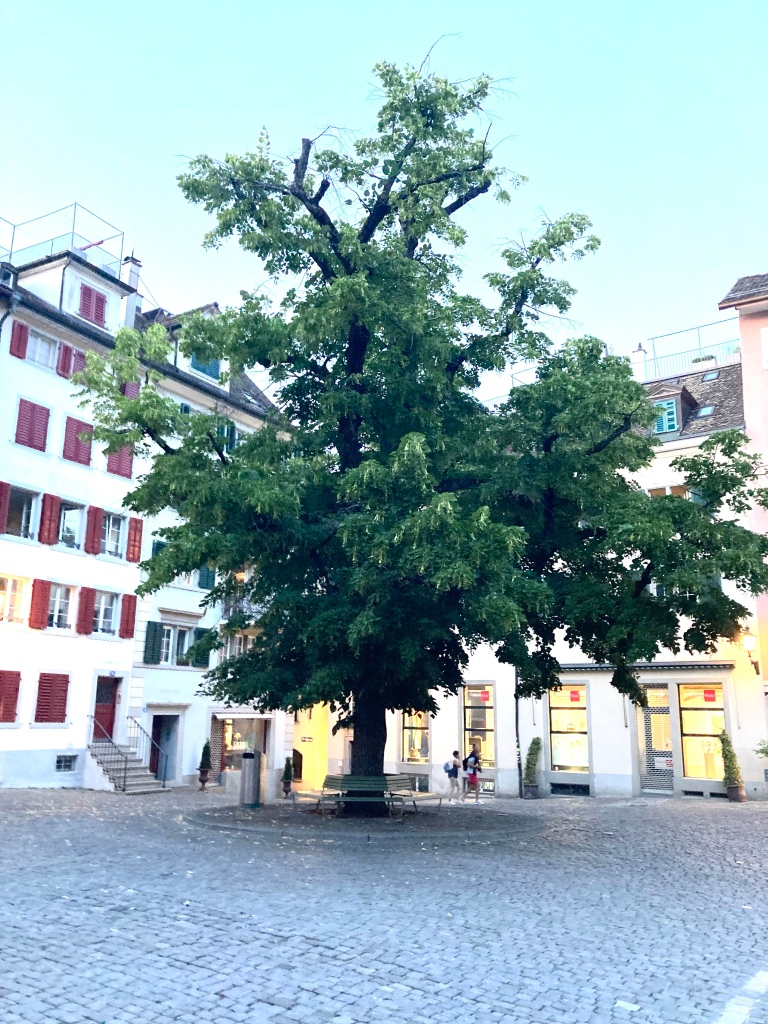
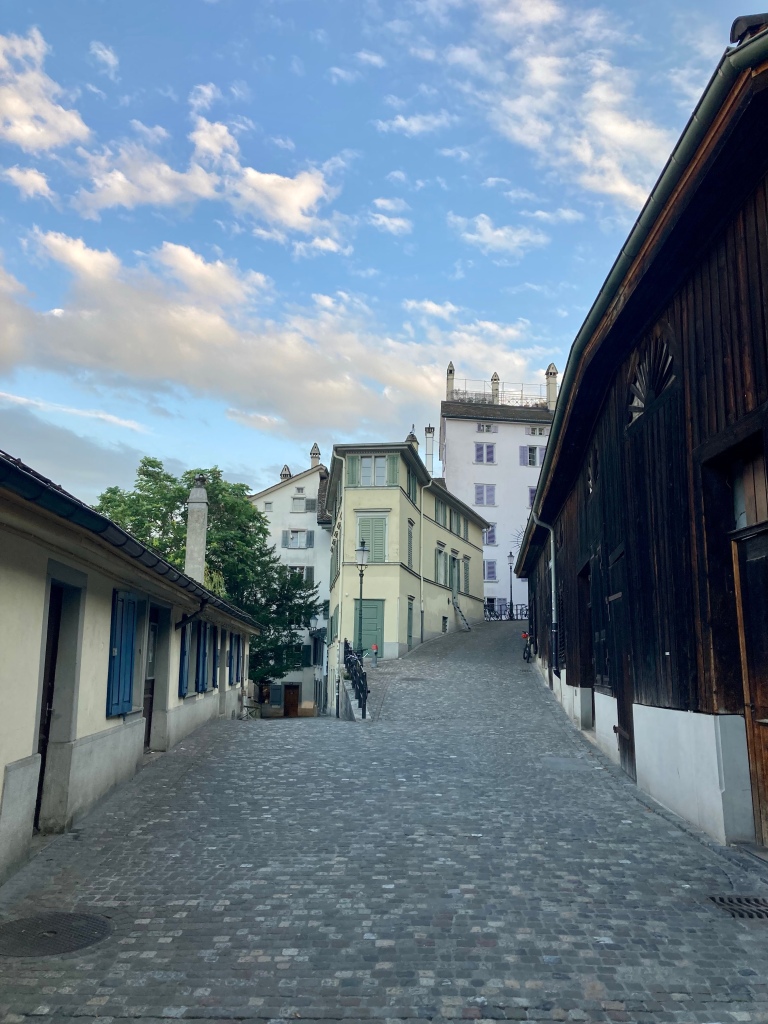
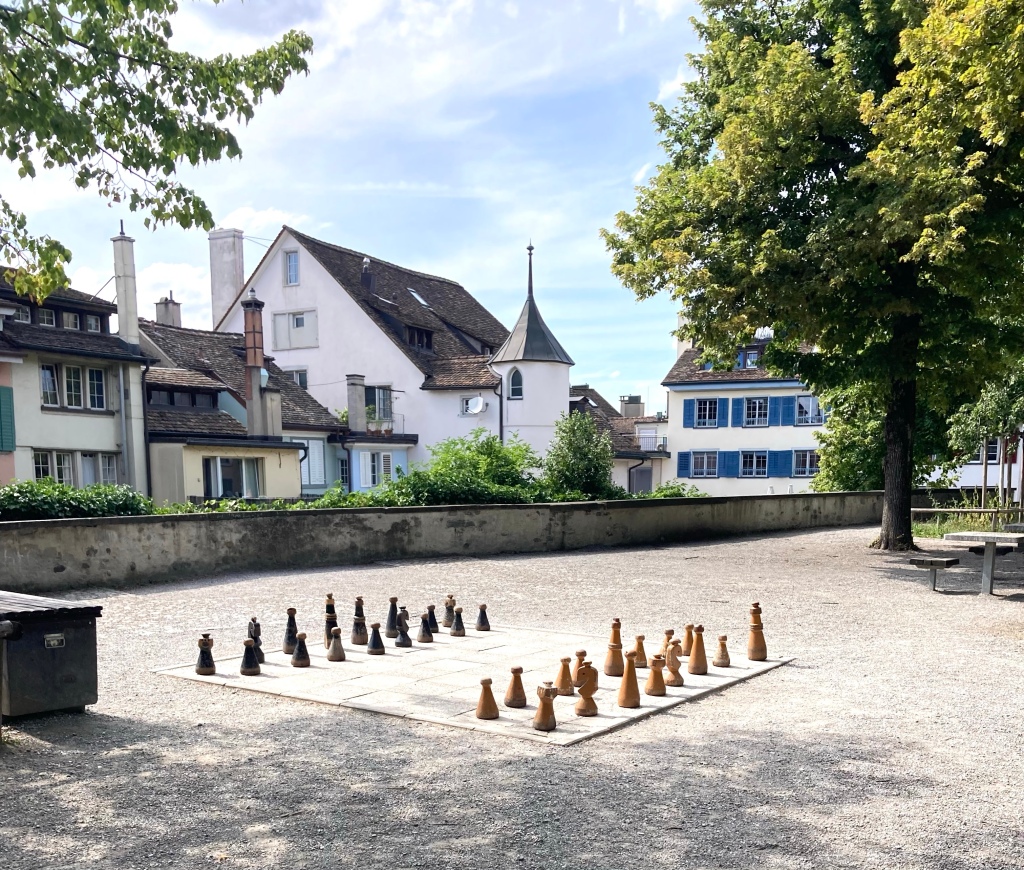
One evening, left to my own devices, when my friend was at a business dinner, I stumbled into a hilly area, of narrow streets, grand old houses and tree shaded garden restaurants. This felt promising, interesting. In a square called St Peterhofstatt, a bench circled a tall lime. A young couple were kissing on it. Until, that is one of them glanced at their watch and the pair speedily parted, standing up and walking away, apparently unruffled, in opposite directions. At some level, I felt adrift inside a series of postcards – able to view the scenery, but never get up close.
I moved on, through a narrow street filled with buildings hung with Swiss flags, in case you’d forgotten where you were. The steeple of a nearby church was decorated with what looked like giant fish, or whales perhaps.
Energised by my glimpse of these stone sea creatures, I went up a flight of stairs and into a square with a view: Lindenhoff. Historically the site of a Roman oppidum. Today the space is a tree planted plaza, offering pleasing views across the Limmat river, the Münsterbrücke bridge and the soaring towers of the Grossmünster – the medieval cathedral where Huldrych Zwingli stirred and debated, pushing against the Catholic Church, spurring, ultimately the Swiss Reformation.
Somewhere else across the water, was the Cabaret Voltaire. On this bank, groups of men politely applauded as they took turns to carefully move giant chess pieces over stone boards set into the ground. At the edge of the plaza, facing the river, someone cracked a can of beer open with a sudden, shocking crack-fizz – Verzeihung!
The next day I tried walking out of town – imagining there must be some edge, at the edge. I headed west for Uetliberg – a mini-tree covered mountain, offering panoramic views back down across Zurich.
On the way I walked underneath a massive flyover for the A3 Autobahn. It reminded me of the space beneath the M32 at Bristol. Massive concrete pillars held up giant sections of road as cars sped past overhead. Below the pavement, a level area of white shingle ran towards a small stretch of river – the Sihl. Almost invisible amongst the scattered stones, stood a heron. Waiting. As they do. I watched it for a while, enjoying the stillness. This slip of wild beneath a massive cathedral to the car.
Half an hour later, the roads getting ever steeper on the foothills of Uetliberg I passed a large Credit Suisse office block, sited in parkland, with a wood on one side. Out of long grass, a small creature on skinny legs trotted across the path. For a second, I didn’t know what I was looking at, then I realised – a hedgehog. So used to not seeing these anymore in the UK – I think I’ve seen three living ones in twenty-five years – I felt sad not to instantly recognise what it was. I carried on up, passing the last, steepest tram stop on this side of the city. An old horse trough outside was being used by a young, heavily bearded man to wash his grimy feet. He was wearing a well-worn, dated brown suit.
Above a car park, running into fields, at the brink of the woods and the footpaths traversing Uetliberg, I heard a mewing, in the air. I looked up. A red-kite was circling above. In waves it came closer and closer to where I was standing, before disappearing into the treetops. I walked into the woods, noticing an old-fashioned looking street lamp, towered over by slender birch and fir trees. The scene looked like Narnia without the snow. Following paths winding up towards various viewpoints, I got my panoramic view. The city and the cool blue of the lake looked inviting and attractive from a distance, but not half-so enticing as the shadowy, hint of mountain peaks miles further to the south.
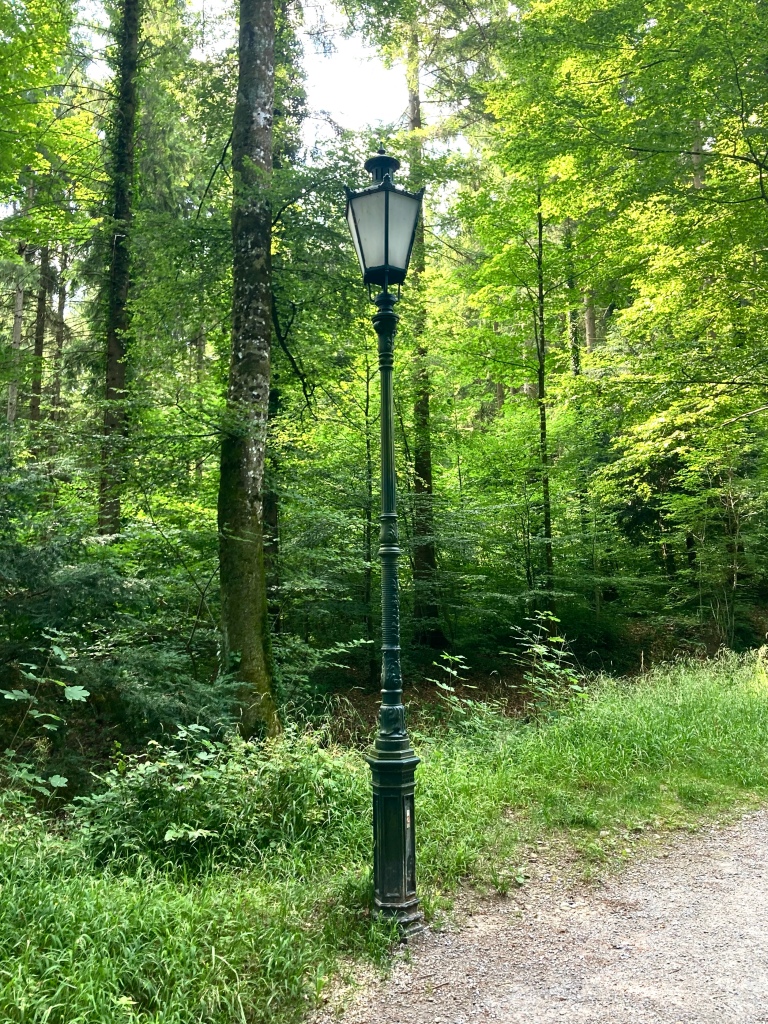
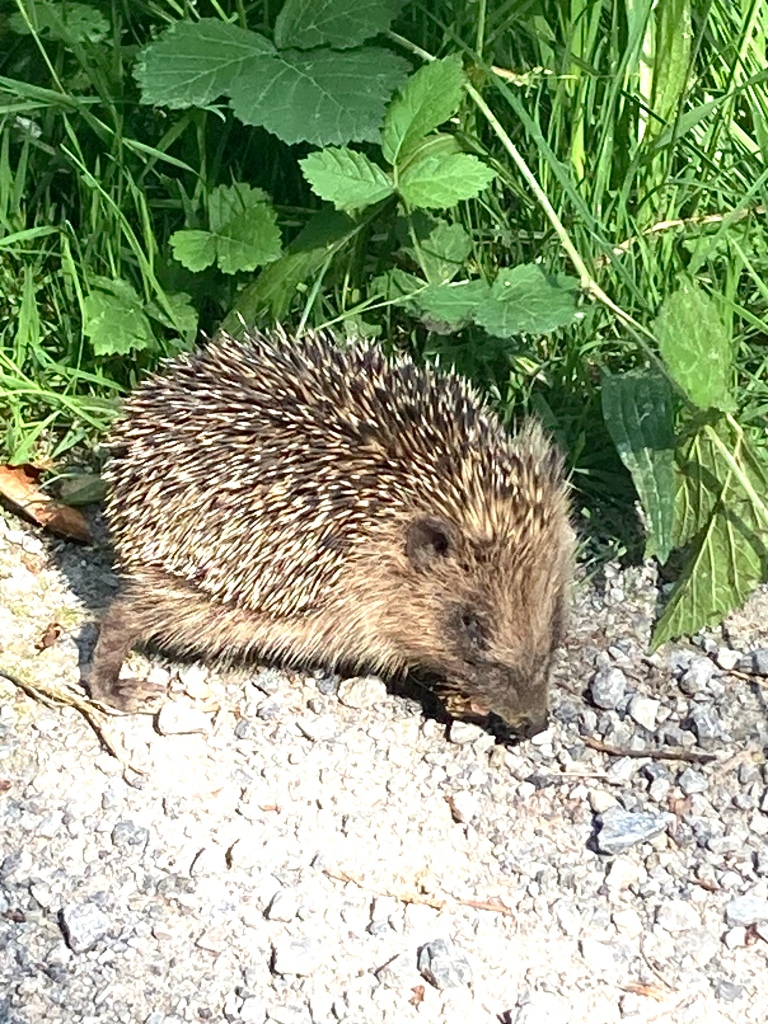
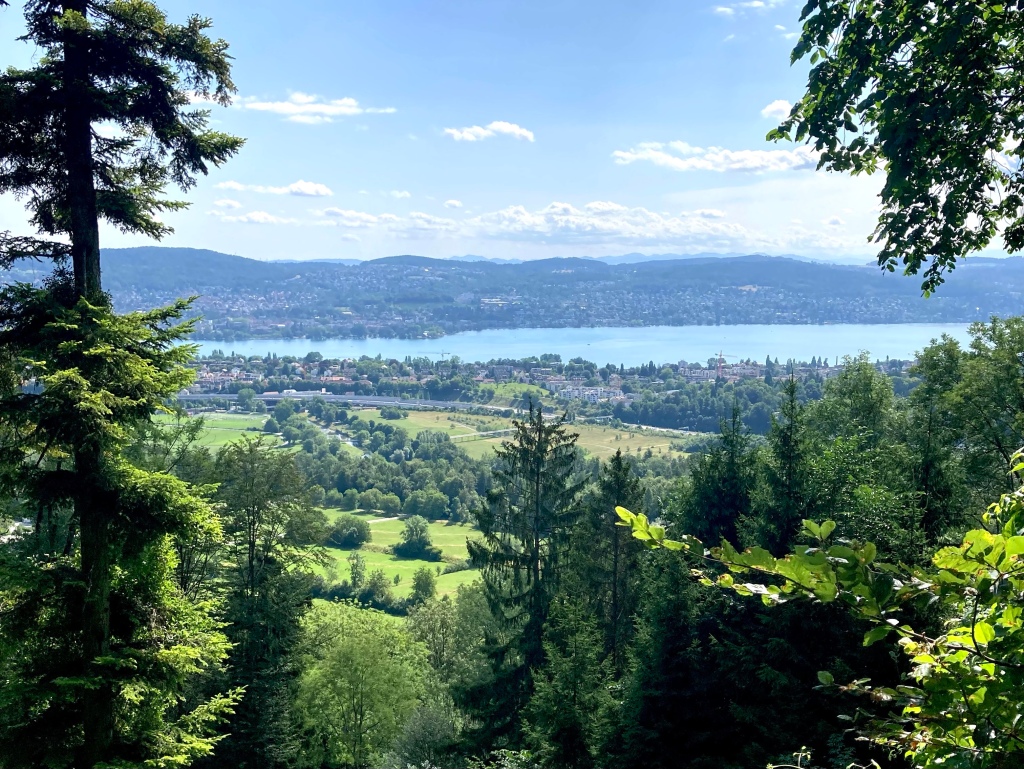
After sitting for a while up here, I made my way back down towards the city again. This time when I passed the trough outside the tram station, the heavily bearded man – homeless I assumed – was roaring and shouting at passers-by, including me. He also splashed water at a lycra-clad cyclist – much to his surprise.
Here was some edge. I don’t speak German, but I’m sure I caught something like the word ‘Katastrophe’ as he sloshed another plume of water at a pedestrian. I hurried past, walking by the hulking brown block of Credit Suisse again. A helicopter thundered overhead. An idea occurred. In 21st century Zurich, maybe the edge is no longer found in Dadaist art, or Modernist writing, but is centred in the world of money.
The bank I had just walked past had been taken over by UBS earlier this year – encouraged to do so, no doubt, by the Swiss government – after accumulating massive regulatory fines in the USA for a series of failures in dealing with dubious hedge-funds.
Perhaps, elsewhere in the city, down a leafy strasse, behind a solid, polished wooden door, bankers, or hedge fund managers were quietly furnishing the city and the world beyond with all the edgy risk and danger it could ever need.




I spent a very pleasant day in Zurich and had very similar thoughts to you. I became quite nostalgic for dear old British grime. I have a theory that our grime is a subterranean spring source of our creativity in music and art.
LikeLiked by 1 person
Hey Alex. Yes pretty city, strangely odd. Went to Belgrade a few months later. Rather different vibe…
LikeLiked by 1 person
In the late 1980s my husband lived in Paris. At dinner one night in his local restaurant we overheard someone speaking in English to his fellow diners explaining that he lived in Zurich because it was the easiest city to leave and go to any one of the other countries.
LikeLiked by 1 person
I think money very much rules here.
LikeLiked by 1 person
Thank you so much. I travelled well with you.
LikeLiked by 1 person